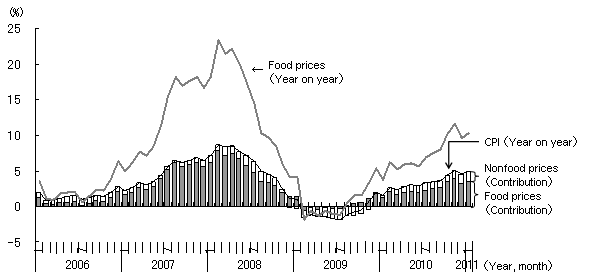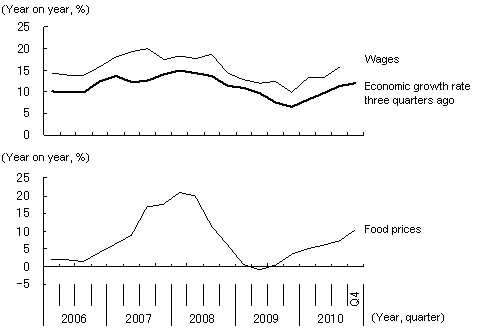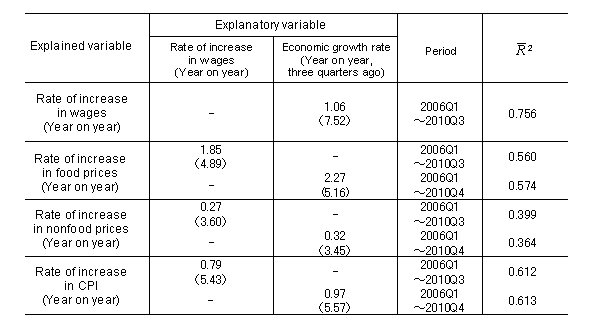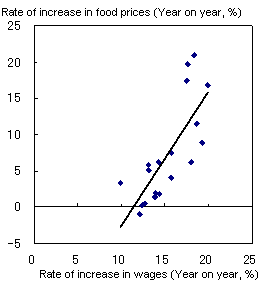Both CPI and food prices depend on the pace of economic growth
In China, the inflation rate in terms of the consumer price index (CPI) has risen to its highest level since the collapse of Lehman Brothers in September 2008. This primarily reflects a rise in the prices of food, which now account for about one third the weight of the CPI (Figure 1). The rate of increase in food prices was 10.3% in January 2011, far higher than the overall inflation rate of 4.9%. The movement of food prices will be the key factor determining the future course of inflation.
| Figure 1: Rising Food Prices as the Major Source of Inflation | |
 | |
| (Source) | Prepared by Chi Hung KWAN based on data of the National Bureau of Statistics of China |
Food prices in China are widely believed to be most influenced by weather and movements in overseas markets and not much related to domestic business conditions, but this is not necessarily true. In fact, there are close links among the economic growth rate in terms of real GDP, wages, and food prices (all of which are measured on a year-on-year basis), and the correlation is even stronger if the time lags among the variables are taken into account (Figure 2).
Fluctuations in economic activity may lead to changes in food prices (and in turn the CPI) through changes in wages. To verify this hypothesis, we have checked 1) the relationship between the economic growth rate and the rate of increase in wages, 2) the relationship between the rate of increase in wages and the rate of increase in food prices, and 3) the relationship between the economic growth rate and the rate of increase in food prices with regression analysis using quarterly data since the first quarter of 2006, taking the time lag between the variables into account. The results are summarized as follows (Table 1).
First, the rate of increase in wages (year on year) is strongly correlated with the economic growth rate three quarters ago. The elasticity of the rate of increase in wages with respect to the economic growth rate three quarters ago is estimated at 1.06% (that is, if the latter rises one percentage point, then the former will rise 1.06 percentage points), confirming that wages are highly sensitive to the economic cycle.
| Figure 2: Strong Correlation among Economic Growth Rate, Wages, and Food Prices | |
 | |
| (Source) | Prepared by Chi Hung KWAN based on data of the National Bureau of Statistics of China |
| Table 1: Estimation Results based on Regression Analysis | |
 | |
| (Note) | Each coefficient shows the elasticity of the explained variables with respect to the explanatory variables. The values in the parenthesis are t-values. |
| (Source) | Prepared by Chi Hung KWAN based on data of the National Bureau of Statistics of China |
In addition, a rise in wages pushes up food prices and there is no time lag between the two. The elasticity of food prices with respect to changes in wages is estimated to be 1.85% (Figure 3). This is higher than the elasticities of the CPI or nonfood prices with respect to a rise in wages (0.79% and 0.27%, respectively).
| Figure 3: Correlation between the Rate of Increase in Food Price and the Rate of Increase in Wages (2006Q1-2010Q3) | |
 | |
| (Note) | The straight line shows the regression line based on the estimation result in Table 1. |
| (Source) | Prepared by Chi Hung KWAN based on data of the National Bureau of Statistics of China |
Finally, as in the case of the rate of increase in wages, the rate of increase in food prices (year on year) is also closely correlated with the economic growth rate three quarters ago. The estimation shows that if the growth rate three quarters ago rises one percentage point, the rate of increase in food prices in the current quarter will climb 2.27 percentage points. This is higher than the elasticities of the CPI or non-food prices (both are the rate of increase) with respect to the economic growth rate (0.97 % and 0.32%, respectively) (*1).
Explanation based on the Balassa-Samuelson hypothesis
This relationship among the economic growth rate, wages, and food prices (and in turn CPI) can be explained as follows based on the Balassa-Samuelson hypothesis, which appears in textbooks on international economics (*2).
Consider an economy comprising two sectors, namely the tradable good sector (which is open to the international market and usually attains high productivity growth) and the non-tradable good sector (which is closed to the international market and usually registers low productivity growth. If economic growth accelerates, demand for labor will increase and wages will rise, which in turn boosts inflationary pressure. In the tradable good sector, even if wages rise, it is difficult to pass cost increases onto prices as its output will be exposed to competition in the international market. In addition, the upward pressure on prices will be partly absorbed by the relatively high growth in productivity. In contrast, in the non-tradable good sector, wages will also rise as they do in the tradable good sector, given free mobility of labor between sectors. Even so, cost increases are easily translated onto higher prices even if the rise in productivity is low, as its output will not be exposed to international competition. As a result, inflation will accelerate mainly in the form of rising prices in the non-tradable good sector.
Generally, the manufacturing sector and agricultural sector that produce food are classified as tradable sectors, while the service sector is classified as non-tradable. In China, however, given the country's very high food self-sufficiency rate of over 95% which helps insulate the domestic market for food from overseas market conditions, food should be regarded as a non-tradable good, rather than a tradable good (*3). In that case, a wage hike associated with an acceleration of economic growth will push up prices, mainly through a rise in food prices, as indicated by the results of the aforementioned empirical analysis (*4).
Inflation rate approaching a turning point
In China, the economic growth rate has been declining moderately, from 11.9% at its peak in the first quarter of 2010, following the change in its monetary policy stance, from easing to tightening to control inflation, in addition to the tapering off of the effect from the four trillion yuan stimulus package used to boost domestic demand after the collapse of Lehman Brothers. Give that the rates of increase in wages and food prices and in turn the CPI lag three quarters behind the economic growth rate, the inflation rate, which has been rising to date, is expected to reach a turning point sooner rather than later.


